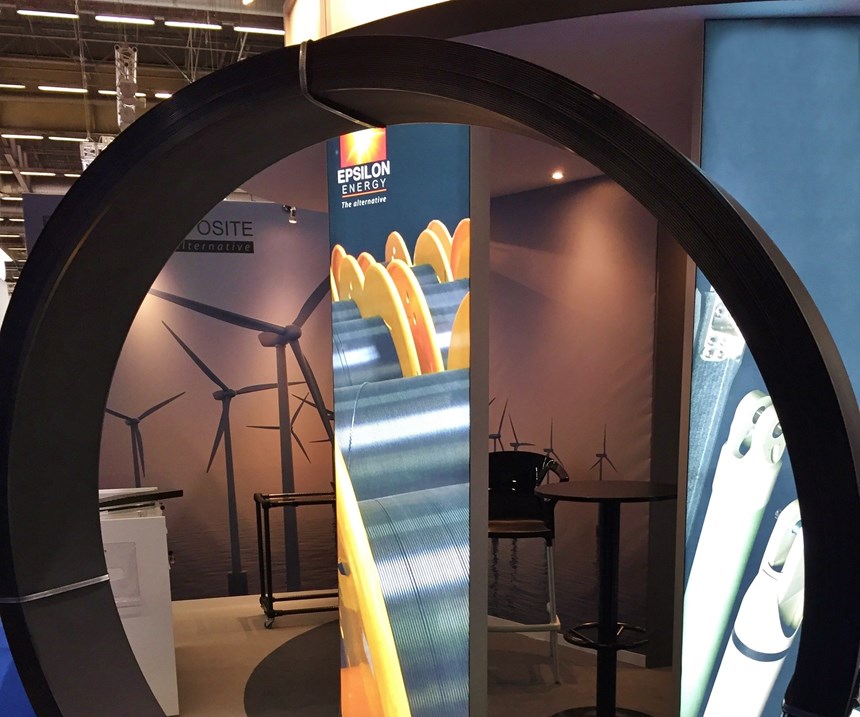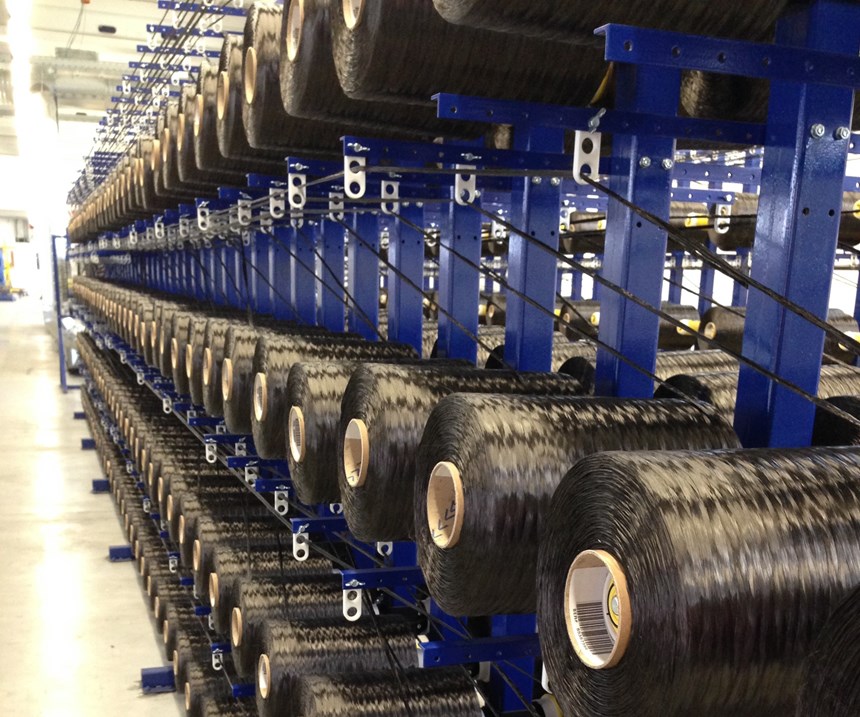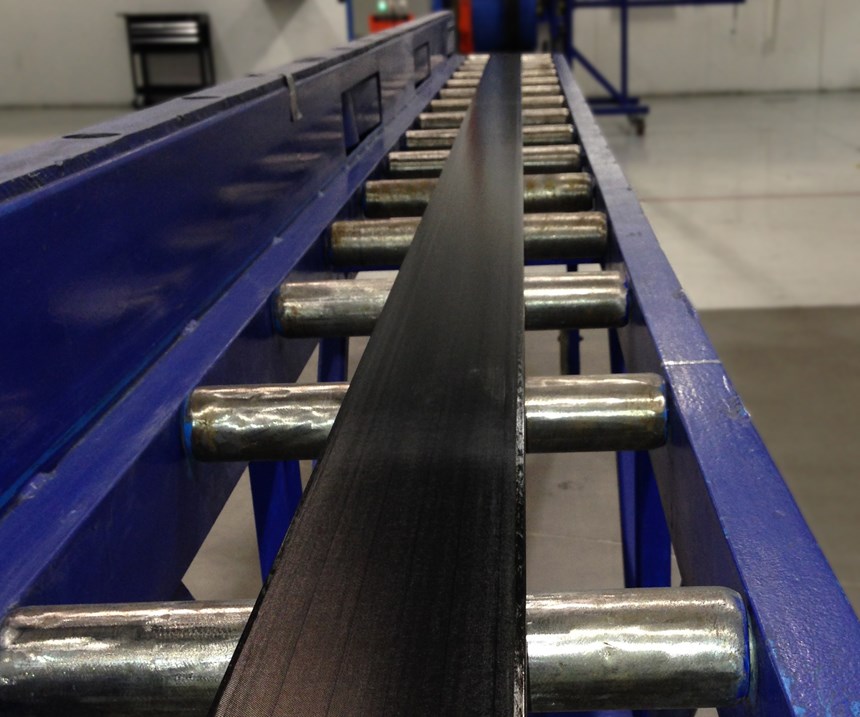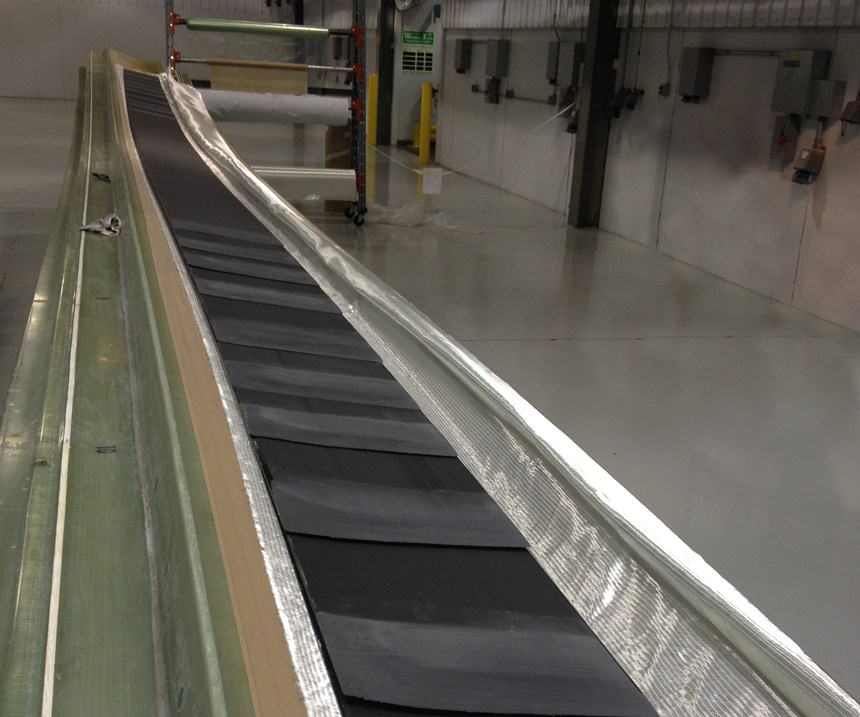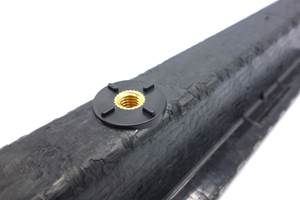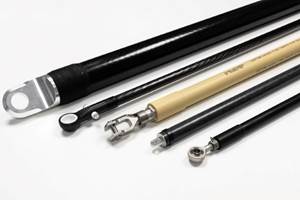Introduced to the market about five years ago, pultruded, carbon fiber-reinforced spar caps, incorporated as the reinforcing member of wind turbine rotor blades, are a byproduct of the evolution and increasing technological sophistication of the global wind energy industry. Twenty or more years ago, when the first large-scale, commercial wind-generated power came on line, wind farms comprised turbines rated at 1 MW or less with glass fiber-reinforced blades that typically ranged from 10 to 15m in length. Today, offshore, 6 to 9 MW turbines with blades 65 to 80m long are the norm. GE Renewable Energy recently announced a 12-GW offshore wind turbine that will use 107m-long blades.
From an engineering and generator’s perspective, the rationale for longer blades and larger turbines is straightforward. According to Betz’s law, the extraction of power output from kinetic wind energy by a turbine is proportional to the product of the wind velocity cubed and the effective area swept by the turbine blades — π(r/2), where r is the rotor diameter), with a maximum achievable conversion efficiency of 59.3%. Generally, the longer the blades, therefore, the higher the efficiency. That said, TPI Composites (Scottsdale, AZ, US) president Steve Nolet adds that the BEM (blade element momentum) Theory also postulates a secondary contribution based on its governing property, which is tip-speed ratio, or the ratio of incoming airflow speed to the tip speed of the rotor blades.
Philip Schell, executive VP, carbon fiber, Zoltek Corp. (St. Louis, MO, US), says as blades get longer, the properties of deflection and stiffness become more critical in turbine blade design and performance. “The spar cap needs to be able to handle a certain predicted level of tensile and compressive loading,” Schell says, noting that in addition to being about 30% lighter than glass by volume, carbon fiber has roughly three times the tensile strength and one-and-a-half times the compressive strength of glass — ballpark figures that can vary slightly depending on the types of carbon and glass fibers being compared. TPI’s Nolet says that although reduced weight, an improvement in compressive strain and a reduction in axial fatigue certainly contribute to blade useful life the use of carbon fiber composite spars is motivated primarily by the need to “limit deflection of these super-sized upwind rotors that must avoid tower strikes during operation and in the environment of stochastic winds and uncertain loading.”
Pultruded plate for spars
Zoltek, a wholly owned subsidiary of Toray Carbon Fiber (Tokyo, Japan) since 2014, supplies more than 12,000 MT of carbon fiber materials to the wind energy market per year, and is adding new capacity at its facility in Guadalajara, Mexico, this year — in part, to meet demand for new projects in the wind energy market. Its product line includes PX 35 Tow and PX 35 unidirectional fabric, but also includes PX 35 Prepreg and, important for this discussion, PX 35 Pultruded plate.
Zoltek entered the pultrusion market about four years ago at the behest of one of its customers and, according to Schell, is today one of the largest producers of carbon fiber-reinforced pultruded plate in the world.
“There’s a lot of interest in pultruded carbon fiber spar caps right now,” Schell reports, noting that Zoltek has related development projects in the works with many of the world’s largest wind turbine manufacturers. “One of the appealing facets about carbon fiber spar caps is that it opens the door to design not only lighter, but thinner, blades with improved aerodynamic performance,” he says. This feature of the materials, when fully optimized, means that the increased cost in materials can, over time, be offset by greater annual energy production (AEP) and levelized cost of energy (LCOE).
Zoltek pultrudes plate at its US manufacturing plant, and at facilities in Hungary and Japan. The process entails feeding PX 35 carbon fiber tow into a pultrusion die and, typically, infusing with a thermoset resin (vinyl ester, epoxy or polyurethane), to produce plate 3-6 mm thick, in widths of 75-300 mm. The unidirectional, laminate plate has a low void content (<1%), a density of approximately 1.55 g/cc, and can be specified with volumetric fiber content of 58-70%. A peel ply can be applied to both sides of the plate during the process and removed prior to stacking within the spar cap tool, providing a clean, activated surface for infusion and laminating. Unlike fabric or prepreg prior to infusion, the properties of the plate are already fixed, a feature that appeals to blade designers, certification agencies and manufacturers because it eliminates most of the potential variance in properties of the final part.
Maxing out compressive properties
This last point is significant, because the mechanical properties of parts made from a unidirectional material are fiber-dominated — that is, when loaded in the tensile and compressive directions, as they are in a rotating turbine blade, the amount and type of fiber determines the performance (as opposed to multiaxial laminates, which are resin dominated). For carbon fiber, the tensile properties are higher than the compressive, meaning, from a design perspective, compressive strength is the limiting property in a spar cap’s construction. Any improvement in compressive strength, with respect to carbon fiber or glass fiber structures, that can be realized in neat material properties provides engineers with greater design flexibility. This fundamental principle also highlights the prime reason pultrusion has become the preferred method to manufacture carbon fiber spar caps.
In a unidirectional tape, laminate defects, such as voids or misaligned fibers, have an exaggerated, deleterious effect on mechanical properties, and can reduce even further the modest advantage in compressive strength carbon fiber wields over glass fiber. Employing pultrusion to manufacture spar cap laminates, says Romain Coullette, commercial director, Epsilon Composite (Gaillen en Medoc, France), makes sense because pultrusion is, arguably, one of the most stable, repeatable and cost-competitive composites manufacturing processes.”
In 2013, Epsilon launched its trademarked Carboglulam pultrusion process to produce stackable carbon fiber laminate for the manufacture of spar caps. Since then, the company has introduced a “next generation” version of the composite, with improved compressive properties as benchmarked against a fabric and prepreg commonly used in structural turbine applications — targeted at spar caps for turbines expected to be operating in prolonged, high-velocity wind conditions.
The latest formulation features volumetric fiber content up to 70%, compared to the initial version, which had fiber content of ~60%.
Epsilon also designed a pultrusion system that controls and aligns each fiber independently to ensure accurate fiber orientation in the 0° axis, thus obviating potential micro-buckling. Lastly, the fibers are infused with a toughened epoxy system (as opposed to vinyl ester in the first formulation) with improved fiber/resin adhesion and higher interlaminar shear strength (>75 MPa). Coullette says an additional benefit of the laminate, which is also produced in rolls of various widths and thicknesses, with peel ply on both sides, is an improved modulus (168 GPa) facilitating the design of thinner spar caps, especially in the flange areas. That, in turn, permits a reduction in overall blade thickness.
Coullette says Epsilon is collaborating in several testing and development projects with customers, who currently use either glass or carbon prepreg to manufacture turbine spar caps, evaluating the pultruded carbon fiber laminate’s performance and cost characteristics as a potential replacement material. Epsilon’s pultrusion manufacturing facility, according to Coullette, has annual capacity of 1,500 MT.
Schell estimates that, globally, about 25% of wind turbines are now manufactured with carbon fiber spar caps. Although that figure is trending upward, it also underscores that most turbines are still built entirely from glass fiber composites. Is there a cut-off point, in terms of turbine size, at which engineering necessity would favor carbon spar caps over glass? “Large, glass-fiber spar caps can be built simply by adding more material to achieve the required mechanical properties,” he observes, “but at some point it becomes so heavy it makes more sense to use carbon.”
Schell cites a 2012 study by Sandia National Laboratories (Albuquerque, NM, US) researchers comparing cost and performance of a 100m, all-glass reinforced “baseline” turbine blade designed for a 13.2 MW turbine, to an identical, hypothetical blade substituting a spar cap made from unidirectional carbon fiber laminate. The analysis predicts a 28% mass savings (31,861 kg) for the carbon fiber spar vs. the all-glass variant. The weight savings derives from the fact that large-blade design is driven by fatigue life and panel buckling resistance. Reducing mass not only reduces the gravitational loads on the blades — thereby enhancing its fatigue performance — but it also facilitates the design of a spar cap 63% thinner than the baseline glass version, with reduced reinforcement required in webbing and along the blade’s trailing edge. Furthermore, there is the previously mentioned benefit of improved aerodynamic performance.
Schell says that when all cost/performance trade-offs are considered, as in the Sandia-type analysis, a solid case can be made for substituting carbon fiber for glass fiber in the manufacture of spar caps for turbine blades 55m in length and longer.
Realizing that in practice, Schell allows, will hinge on sustaining improvements in both pultruded carbon fiber laminate cost and properties, especially compressive strength and modulus.
“Carbon will not buy it’s way on a blade because of hype…,” say Nolet. “It must drive lower LCOE.” But he expresses confidence that carbon can and will do just that because it is part of a larger system. “Weight reduction in the rotor can drive reduced aero and inertial loading,” he notes, adding that there are cascading benefits that often get overlooked. If blade weight is reduced, the size and, therefore, the weight and cost of the blade drivetrain also can be reduced. Each component — the input shaft, gearbox, pitch bearing — can be made less expensively, “ultimately reducing tower and foundation mass,” he points out. “These savings can and likely will offset the cost of carbon over other material choices,” he contends. “Therefore, they will positively impact the economics and ROI [return on investment].”Related Content
Exel Composites pultruded rods enhance Umbrosa parasol durability
The Belgium-based manufacturer chose pultruded fiberglass ribs for many of its umbrella and parasol designs to effectively endure exposure to high wind speeds, saltwater, rain and UV.
Read MoreRobotized system makes overmolding mobile, flexible
Anybrid’s ROBIN demonstrates inline/offline functionalization of profiles, 3D-printed panels and bio-based materials for more efficient, sustainable composite parts.
Read MoreSeat frame demonstrates next-generation autocomposites design
Light weight, simplified/cost-effective manufacturing, passenger comfort and safety informed materials and process innovations and won awards for the 2022 Toyota Tundra‘s second-row seat frame.
Read MoreNovel processes for hybrid thermoset-thermoplastic pultruded parts
CFRP pultrusion and pullwinding specialist Epsilon Composite combines thermoplastic overmolding with traditional thermoset processes, demonstrated through aircraft struts and industrial applications.
Read MoreRead Next
All-recycled, needle-punched nonwoven CFRP slashes carbon footprint of Formula 2 seat
Dallara and Tenowo collaborate to produce a race-ready Formula 2 seat using recycled carbon fiber, reducing CO2 emissions by 97.5% compared to virgin materials.
Read MorePlant tour: Daher Shap’in TechCenter and composites production plant, Saint-Aignan-de-Grandlieu, France
Co-located R&D and production advance OOA thermosets, thermoplastics, welding, recycling and digital technologies for faster processing and certification of lighter, more sustainable composites.
Read More“Structured air” TPS safeguards composite structures
Powered by an 85% air/15% pure polyimide aerogel, Blueshift’s novel material system protects structures during transient thermal events from -200°C to beyond 2400°C for rockets, battery boxes and more.
Read More


